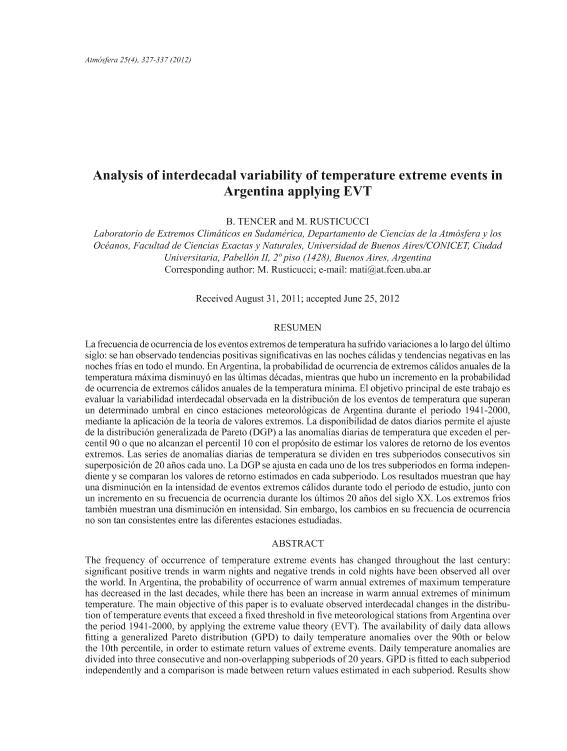Artículo
La frecuencia de ocurrencia de los eventos extremos de temperatura ha sufrido variaciones a lo largo del último siglo: se han observado tendencias positivas significativas en las noches cálidas y tendencias negativas en las noches frías en todo el mundo. En Argentina, la probabilidad de ocurrencia de extremos cálidos anuales de la temperatura máxima disminuyó en las últimas décadas, mientras que hubo un incremento en la probabilidad de ocurrencia de extremos cálidos anuales de la temperatura mínima. El objetivo principal de este trabajo es evaluar la variabilidad interdecadal observada en la distribución de los eventos de temperatura que superan un determinado umbral en cinco estaciones meteorológicas de Argentina durante el periodo 1941-2000, mediante la aplicación de la teoría de valores extremos. La disponibilidad de datos diarios permite el ajuste de la distribución generalizada de Pareto (DGP) a las anomalías diarias de temperatura que exceden el percentil 90 o que no alcanzan el percentil 10 con el propósito de estimar los valores de retorno de los eventos extremos. Las series de anomalías diarias de temperatura se dividen en tres subperiodos consecutivos sin superposición de 20 años cada uno. La DGP se ajusta en cada uno de los tres subperiodos en forma independiente y se comparan los valores de retorno estimados en cada subperiodo. Los resultados muestran que hay una disminución en la intensidad de eventos extremos cálidos durante todo el periodo de estudio, junto con un incremento en su frecuencia de ocurrencia durante los últimos 20 años del siglo XX. Los extremos fríos también muestran una disminución en intensidad. Sin embargo, los cambios en su frecuencia de ocurrencia no son tan consistentes entre las diferentes estaciones estudiadas. The frequency of occurrence of temperature extreme events has changed throughout the last century: significant positive trends in warm nights and negative trends in cold nights have been observed all over the world. In Argentina, the probability of occurrence of warm annual extremes of maximum temperature has decreased in the last decades, while there has been an increase in warm annual extremes of minimum temperature. The main objective of this paper is to evaluate observed interdecadal changes in the distribution of temperature events that exceed a fixed threshold in five meteorological stations from Argentina over the period 1941-2000, by applying the extreme value theory (EVT). The availability of daily data allows fitting a generalized Pareto distribution (GPD) to daily temperature anomalies over the 90th or below the 10th percentile, in order to estimate return values of extreme events. Daily temperature anomalies are divided into three consecutive and non-overlapping subperiods of 20 years. GPD is fitted to each subperiod independently and a comparison is made between return values estimated in each subperiod. Results show that there is a decrease in the intensity of warm extreme events during the whole period, together with an increase in its frequency of occurrence during the last 20 years of the twentieth century. Cold extremes also show a decrease in their intensity. However, changes in their frequency of occurrence are not so consistent between the different stations analyzed.
Analysis of interdecadal Variability of Temperature Extreme Events in Argentina applying EVT
Fecha de publicación:
10/2012
Editorial:
Universidad Nacional Autónoma de México. Centro Ciencias de la Atmósfera
Revista:
Atmósfera
ISSN:
0187-6236
Idioma:
Inglés
Tipo de recurso:
Artículo publicado
Clasificación temática:
Resumen
Archivos asociados
Licencia
Identificadores
Colecciones
Articulos(OCA CIUDAD UNIVERSITARIA)
Articulos de OFICINA DE COORDINACION ADMINISTRATIVA CIUDAD UNIVERSITARIA
Articulos de OFICINA DE COORDINACION ADMINISTRATIVA CIUDAD UNIVERSITARIA
Citación
Tencer, Barbara; Rusticucci, Matilde Monica; Analysis of interdecadal Variability of Temperature Extreme Events in Argentina applying EVT; Universidad Nacional Autónoma de México. Centro Ciencias de la Atmósfera; Atmósfera; 25; 4; 10-2012; 327-337
Compartir




